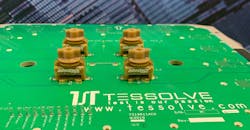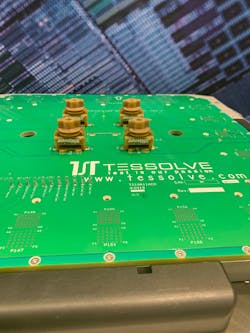Test Capabilities Offer Reinforcement at Higher Frequencies
Not surprisingly, National Instruments (NI) made its presence felt at the recent IMS 2019, bringing an array of new test solutions. For example, the company expanded the frequency coverage of its vector-signal-transceiver (VST) product family by launching the PXIe-5831 VST, which supports validation and production testing at millimeter-wave (mmWave) frequencies (Fig. 1).
1. The PXIe-5831 VST combined with modular mmWave heads provides coverage for frequencies as high as 44 GHz.
The PXIe-5831 VST incorporates a vector signal generator (VSG), vector signal analyzer (VSA), and high-speed serial interface with FPGA-based real-time signal processing and control. By itself, the VST provides customers with direct signal generation and analysis from 5 to 21 GHz. In addition, the PXIe-5831 can be combined with modular mmWave heads to cover frequencies from 23 to 44 GHz, providing integrated and calibrated switching for as many as 32 channels. Furthermore, the PXIe-5831 offers 1 GHz of instantaneous bandwidth for generation and analysis.
With the PXIe-5831 VST, multichannel beamformers and phased arrays can be measured without the need for additional infrastructure. NI maintains that the new VST helps address time-to-market challenges for X-, Ku-, and Ka-band radar applications, as well as satellite-communications (satcom) components and systems.
“By extending capability to even more radar and satcom frequencies, we are helping address the schedule, cost-of-test, and quality issues inherent in the development of complex transmit/receive systems,” says Luke Schreier, VP and general manager, defense and government business, NI. “As a company, we also gain significant technology leverage between these applications and the commercial 5G sectors, which enables us to more efficiently support the product.”
The PXIe-5831 wasn’t all NI had on hand to showcase at IMS. It also demonstrated a mmWave 5G packaged-part test solution, which was a collaboration between NI and two other companies: Tessolve and Johnstech (Fig. 2).
2. NI, Tessolve, and Johnstech collaborated to create a packaged-part test solution for mmWave 5G applications.
The solution features NI’s Semiconductor Test System (STS) for quad-site mmWave 5G testing. It also includes a mmWave-ready interface board designed and manufactured by Tessolve, as well as Johnstech mmWave contactors (rated up to 100 GHz) for final testing of packaged parts. A Johnstech impedance-controlled socket that featured the company’s IQtouch Micro contactors helped ensure repeatable test measurements.



